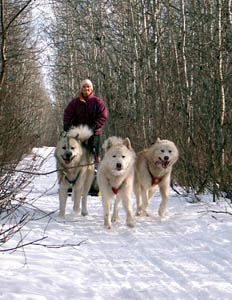In This Issue...
*
Fan Mail
*
F.I.D.O.: Kevin Slater
*
Dog Yard Noise
*
Road Food Inuit Dog Style
*
Differences in Mushing: Greenland and Arctic Canada, Part III
*
How Much is That Doggie in the Window?
*
Product Review: MAXIGUARD® Zn7™ Derm
*
IMHO: People, People, People
Navigating This
Site
Index of articles by subject
Index
of back issues by volume number
Search The
Fan Hitch
Articles
to download and print
Ordering
Ken MacRury's Thesis
Our
comprehensive list of resources
Talk
to The
Fan Hitch
The Fan
Hitch home page
ISDI
home page
Editor's/Publisher's Statement
Editor: Sue Hamilton
Webmaster: Mark Hamilton
The Fan Hitch welcomes your letters, stories, comments and suggestions. The editorial staff reserves the right to edit submissions used for publication.
Contents of The Fan Hitch are protected by international copyright laws. No photo, drawing or text may be reproduced in any form without written consent. Webmasters please note: written consent is necessary before linking this site to yours! Please forward requests to Sue Hamilton, 55 Town Line Rd., Harwinton, Connecticut 06791, USA or mail@thefanhitch.org.
This site is dedicated to the Inuit Dog as well as related Inuit culture and traditions. It is also home to The Fan Hitch, Journal of the Inuit Sled Dog.

Geneviève driving her Balladin team Photo: Montcombroux
How Much Is That Doggie In The Window?
by Geneviève Montcombroux
In the Fall of 2005 and again in the early part of the winter I received a series of bizarre phone calls. The callers all began with a variation of "How much do you sell your pups for?"
Not surprising, perhaps, I would ask who was calling. The response was "I just want to know the price of your dogs." This merited slamming down the phone but I resisted. Painstakingly, I explained that I do not (nor anyone I know in the ISDI ) "sell" dogs for profit. We exchange blood lines. Now and again a dog is placed with a recommended owner for a nominal fee to help cover veterinary and other expenses. A 'recommended' owner is someone known to ISDI members, not someone who phones out of the blue to ask what the sticker price is.
This is why those phone calls were puzzling. After the first two or three, I began tracing the origin of the calls. Not having Caller-ID, I could only find out the area code of the calls, all of which originated in Canada.
It took me a while before I saw the link between those calls and the recent shipping of three pups to Kangiqsualujjuaq in Nunavik. One of the pups was sold for a nominal fee; the other two were gifts.
My suspicions were confirmed when one of our ISDI Inuit members revealed he had been phoned by someone in Canada offering to sell him some Canadian Eskimo dogs for the bargain price of $2,000 CAD each! The ISDI member was too polite to tell the caller he found the name Eskimo (and the price) offensive. I would have had no such reservations. Particularly when the caller inferred that dogs from ISDI members are crossbred. A totally ludicrous allegation.
I am not sure whether to laugh or cry over this. The dogs on offer were CKC registered dogs - a registration which the Inuit, trying to rebuild the breed in the Arctic, have no use for at all. It is widely recognized that the chief role of the Canadian Kennel Club is to promote championship dog shows. The Inuit use their dogs for work, for hunting, for tourism and for traditional pursuits. Nothing in the CKC speaks to the needs of the Inuit. Dog shows play no part in the dog culture of the Arctic. Imagine bathing a weighty dog off a picket line in -30°C (-22°F) weather to ready him for a show!
The person making the offer maintained that the CKC registration 'proved' the dogs were pure, a dubious claim at best. When registering a litter, the Canadian Kennel Club accepts the breeder's word that the details are accurate. There is no routine inspection procedure, though in the past the CKC has commissioned ad hoc inspections, which have revealed some questionable registrations and practices among breeders. The ISDI has rigorous standards for registration in its database.
Supporters of the CKC registered Canadian Eskimo Dogs have criticized the ISDI for breaking away from CKC breed registration and activities (conformation and obedience shows, etc.). ISDI members, whether in Nunavut, Nunavik or elsewhere, subscribe to the higher ideals of preserving the innate qualities of the breed. It is precisely these qualities of hardiness and endurance that enabled the breed to survive for over 4,000 years as an integral component of Inuit traditional life. Rather than primping their dogs for show (and worse, selectively breeding to show standards), ISDI members devote their time to using the dogs in expeditions, for tourism or for outdoor recreation. These activities are closer to the dog's traditional role and do more to maintain the qualities that attracted enthusiasts to the breed in the first place than winning shows and breeding 'champions'!
One can only conclude that the breeder who offered the Inuit of Arctic Quebec CKC registered Canadian Eskimo dogs (the lack of cultural sensitivity aside) is more interested in making a profit than helping the Inuit reestablish their lost heritage through the Inuit Sled Dog recovery project Qimmiit Utirtut.